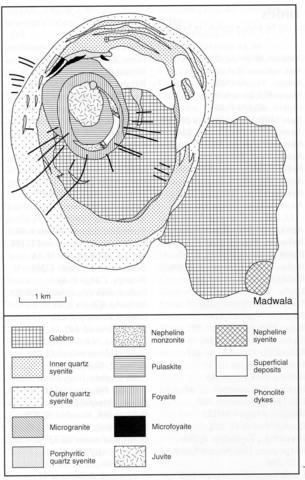stripes
Marangudzi is a ring complex that outcrops over some 80 km2 and is emplaced into granitic basement rocks of the Limpopo orogenic belt. It comprises a body of gabbro that is intruded by ring dykes of quartz syenite, cone sheets of nepheline syenite and radial phonolite dykes (Foland and Henderson, 1976). The order of intrusion is gabbro, inner quartz syenite, outer quartz syenite, porphyritic quartz syenite, nepheline monzonite, pulaskite, foyaite, microfoyaite and juvite. The temporal and petrological relationships of the highly silica undersaturated rocks of the separate small intrusion of Madwula, to the southeast of the complex, are not known. The gabbros consist of zoned augite, a little orthopyroxene, up to 20% olivine and up to 3% biotite; there is accessory apatite and magnetite with minor orthoclase in some rocks (Hossain, 1970). Detailed petrographic descriptions of the nepheline syenites do not appear to have been published but according to Foland and Henderson (1976) some of the gabbros contain nepheline and tend towards syenogabbro. Nepheline monzonites contain more biotite, alkali feldspar and nepheline than the syenogabbros. The pulaskites are equigranular plagioclase-bearing nepheline syenites and the foyaites usually contain little or no plagioclase and are characterised by the presence of orientated alkali feldspar prisms. Modal alkali feldspar and nepheline increase and plagioclase and hastingsitic amphibole decrease through the series monzonite, pulaskite, foyaite (Henderson and Gibb, 1972). Juvites are coarse-grained nepheline-rich rocks with highly potassic K-feldspar. Pseudoleucite occurs in some of the nepheline syenites, particularly the juvites and phonolites. The dominant silica oversaturated rocks are quartz syenites but there are some granites. All rock types are potassic and an AFM diagram in Foland and Henderson (1976) demonstrates a smooth and continuous series from the gabbros through monzonites to the nepheline syenites. Henderson and Gibb (1972) have described nepheline-plagioclase intergrowths in pulaskites and Henderson (1968) describes the chemistry of hastingsitic amphiboles.
FOLAND, K.A. and HENDERSON, C.M.B. 1976. Application of age and Sr isotope data to the petrogenesis of the Marangudzi ring complex, Rhodesia. Earth and Planetary Science Letters, 29: 291-301.HENDERSON, C.M.B. 1968. Chemistry of hastingsitic amphiboles from the Marangudzi igneous complex, Southern Rhodesia. Papers and Proceedings, International Mineralogical Association 5th General Meeting, (Cambridge, 1966), Mineralogical Society, 291-304.HENDERSON, C.M.B. and GIBB, F.G.F. 1972. Plagioclase-Ca-rich-nepheline intergrowths in a syenite from the Marangudzi complex, Rhodesia. Mineralogical Magazine, 38: 670-7.HOSSAIN, M.T. 1970. Petrology and mineralogy of the Marangudzi ring complex, Rhodesia. PhD thesis (Part 1), University of Manchester. 150 pp. (unpublished)

